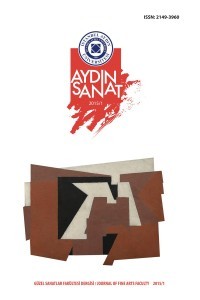Toplumsal ve Teknolojik Gelişmeler Bağlamında Video Sanatı
Fotoğraf ve filmde olduğu gibi video da bir grup sanatçı tarafından keşfedilmiş, yeni bir kitle iletişimaracı olarak kendine özgü yapısal özellikleriyle sanat ortamında yerini almıştır.Videonun bir kitle iletişim aracından sanatsal malzemeye dönüşümünü, toplumsal ve teknolojiksüreçler bağlamında değerlendirmek gerekir. Bu çalışmada, toplumsal gelişmeler açısındanbütün dünyayı etkisi altına alan Sanayi Devrimi ve ardından 1968 yılında gerçekleşen ÖğrenciHareketi ışığında video sanatının evreleri ele alınmıştır. Sanayi devrimi kent kültürünü ve yenitoplumsal sınıfları yaratmış, kitle iletişim araçları ile tüketim alışkanlıklarını yeniden düzenlemiştir.Makineleşmeyle birlikte kas gücü önemini yitirmiş; bilgi, değer kazanmıştır. Tüm bu gelişmelerinbir sonucu olarak değerlendirebileceğimiz 68 kuşağı ise muhalif tavrıyla video sanatının toplumsaltemellerini atmıştır. Teknolojik gelişmeler açısından ise video kameraların geçirdiği fiziksel evrimlebirlikte profesyonel yayıncılardan halka ulaşım süreci değerlendirilmiştir. Ayrıca videonun sanatsalbir malzeme olarak değerlendirilmesi için gerekli niteliğe sahip olup olmaması, fotoğraf ve filmsanatı ile benzerlik kurularak tartışılmıştır.
Anahtar Kelimeler:
Video Sanatı, Sanayi Devrimi, Teknoloji, Toplum
Video Art in the Context of Social and Technological Developments
After the discovery of video as a medium of communication, the artistic exploration was carriedout by a group of artists, such as those in photography and film, and incorporated into the artisticenvironment with its own structural characteristics. It is necessary to evaluate the process oftransforming the video from being a mass media tool to the artistic material in the social andtechnological context. In this study, firstly industrial revolution and then student movement whichtook place in 1968 were examined in terms of social developments related to the developmentof video art. The industrial revolution created urban cultures and new social classes rearrangingmass media and consumption habits. Muscle strength has lost its significance with mechanism,and knowledge has gained value. The 68 generation, which we can consider as a result of allthe developments, has taken the social base of video art with its opposing attitude. In terms oftechnological developments, the process of physical evolution of video cameras and the processof accessing the public through broadcast professionals were evaluated. In addition, whether ornot the video has the necessary qualities to be considered as an artistic material is discussed andresembled with the art of photography and film.
Keywords:
Video Art, Industrial Revolution, Technology, Society,
___
- ALTUNAY, D. A. (2004). Mekanik Sanattan Elektronik Sanata Geçiş ve Video Sanatı, Eskişehir: Anadolu Üniversitesi Yayınları
- ALTUNAY, D. A. (2013). Sanatın Ortamında Video, Eskişehir: Anadolu Üniversitesi Yayınları.
- BLOCH, D. (1983). “Yeni bir sanat türü: Video Sanatı”. Çev. B. Berkman, Milliyet Sanat Dergisi, Dizi: 83, Sıra: 443.
- KILIÇ, L. (1995). “Çoğaltım Aracından Sanat Ortamına” Video Sanatı Eleştirel Bir Bakış, Der. L. Kılıç, İstanbul: Hil Yayın.
- KONGAR, E. (1983). “Videonun Toplumsal Açıdan İşlevi”. Milliyet Sanat Dergisi, Dizi:83, Sıra: 443.
- MARSHALL. S. (1995). “Video: Teknoloji ve Uygulama”. Video Sanatı Eleştirel Bir Bakış, Çev. D. A. Altunay, Der. L. Kılıç, Hil Yayın.
- TANSUĞ. S. (1997). Çağdaş Türk Sanatında Temel Yaklaşımlar, İstanbul: Bilgi Yayınları.
- http://www.mehmetomur.com/sipa-goksinsipahioglu/(15.09.2017).
- http://www.tvnewscheck.com/playout/wpcontent/uploads/2014/03/BW-Portapak.jpg (03.10.2017).
- http://blog.peramuzesi.org.tr/wp-content/uploads/2016/01/fx115515-500x380.jpg (05.10.2017).
- ISSN: 2149-3960
- Yayın Aralığı: Yılda 2 Sayı
- Başlangıç: 2015
- Yayıncı: İstanbul Aydın Üniversitesi
